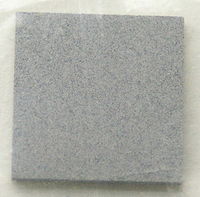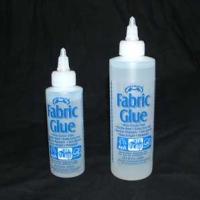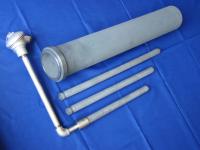INFORMATION
-
High temperature insulation
04 Sep 2013 Posted by adminread more Calcium silicate is commonly used as a safe alternative to asbestos for high temperature insulation materials. Industrial grade piping and equipment insulation is often fabricated from calcium silicate. Its fabrication is a routine part of the curriculum for insulation apprentices. Calcium silicate competes in these realms against rockwool as well as proprietary insulation solids, such as perlite mixture and vermiculite bonded with sodium silicate. Although it is popularly considered an asbestos substitute, early uses of calcium silicate for insulation still made use of asbestos fibers.
Calcium silicate is commonly used as a safe alternative to asbestos for high temperature insulation materials. Industrial grade piping and equipment insulation is often fabricated from calcium silicate. Its fabrication is a routine part of the curriculum for insulation apprentices. Calcium silicate competes in these realms against rockwool as well as proprietary insulation solids, such as perlite mixture and vermiculite bonded with sodium silicate. Although it is popularly considered an asbestos substitute, early uses of calcium silicate for insulation still made use of asbestos fibers.
-
High Temperature Adhesive Types
13 Aug 2013 Posted by adminGemcohesive® is produced from high purity Alumina and Silica raw materials. With its low impurity chemical make-up, it provides improved service life and superior thermal performance over other products on the market. Gemcohesive® is suited for applications up to 1260°C (2300°F). Gemcohesive®-Alumina is a high temperature refractory material produced from high purity Alumina and Silica materials. This product has exceptional thermal stability at elevated temperatures and is recommended for applications above the service limit of Standard Gemcohesive®. Gemcohesive® HT is suited for applications up to 1650°C (3000°F).read more
-
Silicon Nitride Product : Silicon nitride is a chemical compound of silicon and nitrogen. If powdered silicon is heated between 1300 °C and 1400 °C in
11 Aug 2013 Posted by adminread more Silicon Nitride Product : Silicon nitride is a chemical compound of silicon and nitrogen. If powdered silicon is heated between 1300 °C and 1400 °C in an atmosphere of nitrogen, trisilicon tetranitride, Si3N4 is formed. The silicon sample weight increases progressively due to the chemical combination of silicon and nitrogen. Without an iron catalyst, the reaction is complete after several hours (~7), when no further weight increase due to nitrogen absorption (per gram of silicon) is detected. In addition to Si3N4, several other silicon nitride phases (with chemical formulas corresponding to varying degrees of nitridation/Si oxidation state) have been reported in the literature, for example, the gaseous disilicon mononitride (Si2N); silicon mononitride (SiN), and silicon sesquinitride (Si2N3), each of which are stoichiometric phases. As with other refractories, the products obtained in these high-temperature syntheses depends on the reaction conditions (e.g. time, temperature, and starting materials including the reactants and container materials), as well as the mode of purification. However, the existence of the sesquinitride has since come into question.
Silicon Nitride Product : Silicon nitride is a chemical compound of silicon and nitrogen. If powdered silicon is heated between 1300 °C and 1400 °C in an atmosphere of nitrogen, trisilicon tetranitride, Si3N4 is formed. The silicon sample weight increases progressively due to the chemical combination of silicon and nitrogen. Without an iron catalyst, the reaction is complete after several hours (~7), when no further weight increase due to nitrogen absorption (per gram of silicon) is detected. In addition to Si3N4, several other silicon nitride phases (with chemical formulas corresponding to varying degrees of nitridation/Si oxidation state) have been reported in the literature, for example, the gaseous disilicon mononitride (Si2N); silicon mononitride (SiN), and silicon sesquinitride (Si2N3), each of which are stoichiometric phases. As with other refractories, the products obtained in these high-temperature syntheses depends on the reaction conditions (e.g. time, temperature, and starting materials including the reactants and container materials), as well as the mode of purification. However, the existence of the sesquinitride has since come into question.
-
What kind of glue.
05 Aug 2013 Posted by adminread more High Temperature Adhesive : First. Adhesive fabric (Fabric Glue). Was produced to be used for material fabric By this time the adhesive will not harm the skin. And less time to dry. superglue. Two. Glucosamine super glue (Super Glue). Perhaps we could call this type of glue that
High Temperature Adhesive : First. Adhesive fabric (Fabric Glue). Was produced to be used for material fabric By this time the adhesive will not harm the skin. And less time to dry. superglue. Two. Glucosamine super glue (Super Glue). Perhaps we could call this type of glue that
-
Calcium silicate is commonly used as a safe alternative to asbestos for high temperature insulation materials. Industrial grade piping and equipment i
29 Jul 2013 Posted by adminCalcium silicate is commonly used as a safe alternative to asbestos for high temperature insulation materials. Industrial grade piping and equipment insulation is often fabricated from calcium silicate. Its fabrication is a routine part of the curriculum for insulation apprentices. Calcium silicate competes in these realms against rockwool as well as proprietary insulation solids, such as perlite mixture and vermiculite bonded with sodium silicate. Although it is popularly considered an asbestos substitute, early uses of calcium silicate for insulation still made use of asbestos fibers.read more
-
Reractory Castable Product Category : Material Handling Components
16 Jul 2013 Posted by adminReractory Castable Product Category : Material Handling Components Reractory Castable Top & Bottom Blocks is used to hold the induction coil tightly in middle of the tilting furnace box with help of vertical tie rods. Thermafield Power Components Private Limited manufactures Reractory Castable Top & Bottom Blocks. Thermafield Power Components Private Limited supplies different types of induction furnace insulating materials, coil supports and non asbestose sheets, induction furnace hydraulic spares, carbon free hoses, hydraulic cylinders, he plates, duraline induction melting furnace assembly etc. Reractory Castable Top & Bottom Blocks is made from mixture of refractory material, S.S. Reinforcement and certain percentage of water to make the cast formation in fabricated mould. This Reractory Castable Top & Bottom Blocks give the base support to hold the coil and keep in shape while tilting of the furnace.read more
-
Refractory Castable Dry materials that can be combined
15 Jul 2013 Posted by adminRefractory Castable Dry materials that can be combined with water to form a homogenous mass which can be cast in formwork similar to concrete.Castable refractories can be classified into four major groups - dense castables, lightweight or insulative castables, gunning castables, and special purpose castables - sometimes these classifications can be combined, such as lighhtweight gunning castables, or dense gunning castables. Application Dense castables are designed for strength, abrasion and corrosion resistance and are primarily used as the working hot face. Lightweight insulating castables provide low thermal conductivity values behind dense castables, or in certain conditions as working hot face linings. Gunning castables are modified versions of the above castables that allow them to be effectively placed using pneumatic guns. Some grades are dual purpose, allowing both casting and gunning without change.read more
-
Refractory castable Information
15 Jul 2013 Posted by adminCastable Refractories Information CASTABLE REFRACTORIES can be installed similarly to normal concrete. It is very convenient and easy to use for building up the kiln structure. Castable refractories has high refractoriness close to refractory bricks but it can be installed in a shorter time. It consists of high alumina cement and refractory aggregates with a proper grain size distribution, thus it can develop strength after being mixed with a specific amount of water. Castable Refractories has advantages over refractory bricks as it is easy and convenient to use, requires no cutting , has less lead time in manufacturing, thereby reducing the cost of making a new mould if an irregular shape is required, and is suitable for installing in an area where the bricks installation cannot be perfectly done.read more
-
History of Adhesives II
12 Jul 2013 Posted by adminIn Central Asia, the rise of the Mongols in approximately 1000 C.E. can be partially attributed to the good range and power of Genghis Khan's hordes' bows. The bows were constructed with laminated lemonwood and bullhorn bonded by a now unknown adhesive. In Europe, glue was not widely used until the period 1500-1700 C.E. At this time, now world renown cabinet and furniture makers such as Chippendale and Duncan Phyfe began the use of adhesives in their products. Musical instruments made by Antonio Stradivari are believed to have been laminated with a secret connection, including vernice bianca, a varnish made of acacia gum, honey and egg white.read more
-
Silicon Nitride Product
12 Jul 2013 Posted by adminSilicon Nitride Product casatables are extensively used for back-up and hot face linings. Their low density and low thermal conductivity helps in conserving heat energy and reducing fuel costs. These are low iron content insulating castables, suitable for use in reducing atmosphere with higher strengths coupled with the advantage of low thermal conductivities.read more
-
History of Adhesives.
11 Jul 2013 Posted by adminHistory of Adhesives. The earliest use of adhesives was discovered in 2001 in Italy. At this site, two stone flakes partially covered with birch-bark-tar and a third uncovered stone from the Middle Pleistocene era (circa 200,000 years ago) were found. This is thought to be the oldest discovered human use of tar hafted stones. The birch-bark-tar adhesive is a simple, one component adhesive. Although sticky enough, plant based adhesives are brittle and vulnerable to environmental conditions. The first use of compound adhesives was discovered in Sibudu, South Africa. Here, 70,000 year old stone segments that were once inserted in hafts, covered with and adhesive composed of a combination of plant gum and red ochre (natural iron oxide), were found. Adding ochre to plant gum produces a stronger produce and protects the gum from disintegrating under wet conditions.[6] The ability to produce stronger adhesives allowed middle stone age humans to attach stone segments to sticks in greater variations and led to the development of new tools.read more
-
Adhesive types II
10 Jul 2013 Posted by adminIn the year 1951 Dr.Harry Coover has partnered with Dr.Fred Joyner led the cyanobacterium acrylate compounds to new research by the then Dr.Harry Coover moved to the Kodak Company. The Eastman Company in the State of Tennessee, USA Tel. During which they are conducting research on the heat resistance of Acrylate polymers. (Acrylate-polymer) for use in the roof (Canopies) of the jet on Dr.Fred Joyner growing film material for ethyl acrylate cyanobacterium. (Ethylcyanoacrylate) crystalline substance, he has seen it happen more attention.read more
-
Adhesive types
09 Jul 2013 Posted by adminWhen the fracture of materials. Or that we want to connect two materials together. We often use a chemical one. Which has the ability to help coordinate things. Them with good adhesion. Chemicals that help to coordinate this, we often refer to it as the "glue" itself.read more
-
China refractory material product manufacturing Industry, 2010
01 Feb 2013 Posted by admin2010 is valuable for anyone who wants to invest in the refractory material product manufacturing industry, to get Chinese investments; to import into China or export from China, to build factories and take advantage of lower costs in China, to partner with one of the key Chinese corporations, to get market shares as China is boosting its domestic needs; to forecast the future of the world economy as China is leading the way; or to compete in the segment. The report provides in-depth analysis and detailed insight into the refractory material product manufacturing industry, market drivers, key enterprises and their strategies, as well as technologies and investment status, risks and trends.read more
-
High temperature insulation Calcium silicate
30 Jan 2013 Posted by adminread more Calcium silicate (often referred to by its shortened trade name Cal-Sil or Calsil) is the chemical compound Ca2SiO4, also known as calcium orthosilicate and sometimes formulated 2CaO.SiO2. It is one of group of compounds obtained by reacting
Calcium silicate (often referred to by its shortened trade name Cal-Sil or Calsil) is the chemical compound Ca2SiO4, also known as calcium orthosilicate and sometimes formulated 2CaO.SiO2. It is one of group of compounds obtained by reacting
-
Aluminium
30 Jan 2013 Posted by adminAluminium ( /ˌæljuːˈmɪniəm/ al-ew-min-ee-əm) or aluminum (American English; /əˈluːmɪnəm/ ə-loo-mi-nəm) is a chemical element in the boron group with symbol Al and atomic number 13. It is silvery white, and it is not soluble in water under normal circumstancesread more
-
What are Refractory Materials
30 Jan 2013 Posted by adminWhat are Refractory Materials ? There was a time when I would simply pull out my trusty Webster’s Tome. I would efficiently thumb to the desired entry, proudly making full use of the alphabetical skills acquired through years of primary education. Voila! Having quickly located the desired term, I would faithfully and obediently parrot the appropriate definitions. But times have changed, and I have kept up with them. I now depend, as I’m sure is true for most of us, on Google and Wikipedia for my primary didactic guidance.read more
-
Refractory Materials
30 Jan 2013 Posted by adminApplied Diamond 01926485185 Kenilworth, Warwickshire Manufacture and supply of Diamond Tools, Manufacture of other machine tools not elsewhere classified refractories diamond saw blades Clay Pipes Concrete Roof Tiles Arthur Wood Group 01514861888 Liverpool, Merseyside Our latest ranges and special offers at your finger tips The Rayware Group has a dedicated purchasing and design team, which work closely togetherread more
-
Silicon nitride
23 Jan 2013 Posted by adminread more Silicon Nitride Products : Silicon nitride is a chemical compound of silicon and nitrogen. If powdered silicon is heated between 1300 °C and 1400 °C in an atmosphere of nitrogen, trisilicon tetranitride, Si3N4 is formed. The silicon sample weight increases progressively due to the chemical combination of silicon and nitrogen. Without an iron catalyst, the reaction is complete after several hours (~7), when no further weight increase due to nitrogen absorption (per gram of silicon) is detected.
Silicon Nitride Products : Silicon nitride is a chemical compound of silicon and nitrogen. If powdered silicon is heated between 1300 °C and 1400 °C in an atmosphere of nitrogen, trisilicon tetranitride, Si3N4 is formed. The silicon sample weight increases progressively due to the chemical combination of silicon and nitrogen. Without an iron catalyst, the reaction is complete after several hours (~7), when no further weight increase due to nitrogen absorption (per gram of silicon) is detected.
result is 19 units
1
